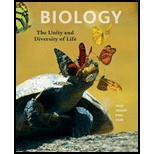
Concept explainers
An endoskeleton consists of _________.
- a. a fluid in an internal space
- b. hardened plat at the surface of a body
- c. internal hard parts
- d. a fluid that surrounds the body
Introduction: A skeletal system is essential for the body support and to protect the internal organs of the body. Our body movements are brought about by the muscles by its interaction with the skeleton. The skeletal system is mainly classified into three- hydrostatic skeleton, endoskeleton and exoskeleton.
Answer to Problem 1SQ
Correct answer: An endoskeleton consists of internal hard parts.
Hence, the correct answer is option c.
Explanation of Solution
Reason for the correct answer:
One of the main types of skeleton is the endoskeleton. Endoskeleton is a structural support found internally within an animal’s body. In humans, the endoskeleton is made up of framework of cartilages and bones. Another example- the sea stars are the echinoderms that contain the endoskeleton which is made up of hard, calcium-rich plates.
Option c. is given as “internal hard parts”.
An internal structural support found inside an animal made up of hard and tough mineralized tissue is termed as endoskeleton. Tissues present in the endoskeletons facilitate the movement by attaching to the muscles.
Hence, the correct answer is option c.
Reasons for the incorrect answers:
Option a. is given as “a fluid in an internal space”.
A fluid-filled internal space that obtains the energy for the contraction of muscles is known as hydrostatic skeleton. It does not contain the internal hard parts.
Hence, option a. is incorrect.
Option b. is given as “hardened plates at the surface of a body”.
This is incorrect because the structural support or the hardened plates that are found externally to support the outer surface of the body is called as exoskeleton. This is different from the endoskeleton.
Hence, option b. is incorrect.
Option d. is given as “a fluid that surrounds the body”.
This is incorrect because interstitial fluids or tissue fluids are the fluid that surrounds the body or are present between cell, blood vessels, and the lymph vessels. These fluids help to supply essential nutrients as well as removing the harmful substances from the spaces.
Hence, option d. is incorrect.
Hence the options a., b., and d. are incorrect.
Want to see more full solutions like this?
Chapter 35 Solutions
Biology: The Unity and Diversity of Life (MindTap Course List)
Additional Science Textbook Solutions
Biological Science (6th Edition)
EBK INTRODUCTION TO CHEMISTRY
Campbell Biology in Focus (2nd Edition)
Introductory Chemistry (6th Edition)
Living By Chemistry: First Edition Textbook
- Describe the levels of structural hierarchy for the human body, starting with the organismal level and ending with the chemical level. In addition, you should make sure you link each level to the previous level, emphasizing the structural relationships.arrow_forward9 S es Read the section "Investigating Life: In (Extremely) Cold Blood." Then, drag and drop the terms on the left to complete the concept map. Red blood cells Genes Icefishes -have mutated have colorless Oxygen have few lack encode Blood Cellular respiration consists of- contain carries is a Platelets White blood cells carries low amounts of Hemoglobin is necessary for Plasma Protein Reset.arrow_forwardPlating 50 microliters of a sample diluted by a factor of 10-6 produced 91 colonies. What was the originalcell density (CFU/ml) in the sample?arrow_forward
- Every tutor here has got this wrong, don't copy off them.arrow_forwardSuppose that the population from question #1 (data is in table below) is experiencing inbreeding depression (F=.25) (and no longer experiencing natural selection). Calculate the new expected genotype frequencies (f) in this population after one round of inbreeding. Please round to 3 decimal places. Genotype Adh Adh Number of Flies 595 Adh Adh 310 Adhs Adhs 95 Total 1000 fladh Adh- flAdn Adh fAdhs Adharrow_forwardWhich of the following best describes why it is difficult to develop antiviral drugs? Explain why. A. antiviral drugs are very difficult to develop andhave no side effects B. viruses are difficult to target because they usethe host cell’s enzymes and ribosomes tometabolize and replicate C. viruses are too small to be targeted by drugs D. viral infections usually clear up on their ownwith no problemsarrow_forward
- This question has 3 parts (A, B, & C), and is under the subject of Nutrition. Thank you!arrow_forwardThey got this question wrong the 2 previous times I uploaded it here, please make sure it's correvct this time.arrow_forwardThis question has multiple parts (A, B & C), and under the subject of Nutrition. Thank you!arrow_forward
- Calculate the CFU/ml of a urine sample if 138 E. coli colonies were counted on a Nutrient Agar Plate when0.5 mls were plated on the NA plate from a 10-9 dilution tube. You must highlight and express your answerin scientific notatioarrow_forwardDon't copy off the other answer if there is anyarrow_forwardAnswerarrow_forward
 Medical Terminology for Health Professions, Spira...Health & NutritionISBN:9781305634350Author:Ann Ehrlich, Carol L. Schroeder, Laura Ehrlich, Katrina A. SchroederPublisher:Cengage Learning
Medical Terminology for Health Professions, Spira...Health & NutritionISBN:9781305634350Author:Ann Ehrlich, Carol L. Schroeder, Laura Ehrlich, Katrina A. SchroederPublisher:Cengage Learning Biology (MindTap Course List)BiologyISBN:9781337392938Author:Eldra Solomon, Charles Martin, Diana W. Martin, Linda R. BergPublisher:Cengage Learning
Biology (MindTap Course List)BiologyISBN:9781337392938Author:Eldra Solomon, Charles Martin, Diana W. Martin, Linda R. BergPublisher:Cengage Learning
 Human Physiology: From Cells to Systems (MindTap ...BiologyISBN:9781285866932Author:Lauralee SherwoodPublisher:Cengage Learning
Human Physiology: From Cells to Systems (MindTap ...BiologyISBN:9781285866932Author:Lauralee SherwoodPublisher:Cengage Learning Biology: The Dynamic Science (MindTap Course List)BiologyISBN:9781305389892Author:Peter J. Russell, Paul E. Hertz, Beverly McMillanPublisher:Cengage Learning
Biology: The Dynamic Science (MindTap Course List)BiologyISBN:9781305389892Author:Peter J. Russell, Paul E. Hertz, Beverly McMillanPublisher:Cengage Learning Biology: The Unity and Diversity of Life (MindTap...BiologyISBN:9781305073951Author:Cecie Starr, Ralph Taggart, Christine Evers, Lisa StarrPublisher:Cengage Learning
Biology: The Unity and Diversity of Life (MindTap...BiologyISBN:9781305073951Author:Cecie Starr, Ralph Taggart, Christine Evers, Lisa StarrPublisher:Cengage Learning





